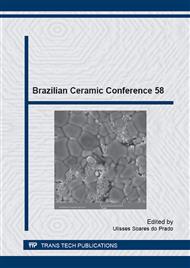[1]
X.Y. Chen, C. Ma, Z. J, Zhang. B.N. Wang: Materials Science and Engineering B Vol. 151 (2008), p.224.
Google Scholar
[2]
I.B. Huang, Y.S. Chang, H.L. Chen, C.C. Hwang, C.J. Jian, Y.S. Chen, M.T. Tsai: Thin Solid Films, Preparation and luminescence of green-emitting ZnAl2O4: Mn 2+ phosphor thin films. Available online, (2014).
DOI: 10.1016/j.tsf.2014.02.104
Google Scholar
[3]
J. Okal, M. Zawadzki: Applied Catalysis Environmental B Vol. 105 (2011), p.182.
Google Scholar
[4]
M.G. Hipólito, J.G. Mendoza, E. Martínez, O.A. Fregoso, C. Falcony: Solid State Physics Vol. 201 (2004), p.1510.
Google Scholar
[5]
M. Kumar, T.K. Seshagiri, M. Mohapatra, V. Natarajan, S.V. Godbole: Journal of Luminescence Vol. 132 (2012), p.2810.
Google Scholar
[6]
X. Li, Z. Zhu, Q, Zhao, L. Wang: Journal of Hazardous Materials Vol. 186 (2011), p. (2089).
Google Scholar
[7]
C. Ma, X.Y. Chen, S.P. Bao; Microporous and Mesoporous Materials Vol. 129 (2010), p.37.
Google Scholar
[8]
J. Song, M. Leng, X. Fu, J. Liu: Journal of Alloys and Compounds: 543 Vol. (2012), p.142.
Google Scholar
[9]
D. Silva, A. Abreu, M.R. Davolos, M. Rosaly: Optical Materials Vol. 33 (2011), 1226.
Google Scholar
[10]
M. Kumar, T.K. Seshagiri, M. Mohapatra, V. Natarajan, S. V. Godbole: Journal of Luminescence Vol. 132 (2012), p.2810.
Google Scholar
[11]
B.S. Vasile, O. Oprea, G. Voicu, A. Ficai, E. Andronescu, A. Teodorescu, A. Holban: International Journal of Pharmaceutics Vol. 463 (2014), p.161.
DOI: 10.1016/j.ijpharm.2013.11.035
Google Scholar
[12]
K. Wang, X. Yuan, Z. Guo, J. Xu, Y. Chen: Carbohydrate Polymers Vol. 102 (2014), p.699.
Google Scholar
[13]
D. Zhang, Y. Yin, Y. Liu, W. Chao, Y. Zhai: Journal of Physics and Chemistry of Solids Vol. 74 (2013), p.1131.
Google Scholar
[14]
S. Kango, S. Kalia, A. Celli, J; Njuguna, Y. Habibi, R. Kumar: Progress in Polymer Science Vol. 38 (2013), p.1232.
DOI: 10.1016/j.progpolymsci.2013.02.003
Google Scholar
[15]
D.H. Park, S.J. Hwang, J.M. Oh, J.H. Yang, J.H. Choy, Progress in Polymer Science Vol. 38 (2013), p.1442.
Google Scholar
[16]
J. Feng, B.D. Hammock, I.M. Kennedy, S. Goumin, A. Maquieira: United States Patent Application Publication, US 2003/0180780 Al, (2003).
Google Scholar
[17]
E. Leal, B.B. Dantas, L.S. Neiva, R.H.G.A. Kiminami, A.C.F.M. Costa: Materials Science Forum Vols. 727-728 (2012), p.1260.
Google Scholar
[18]
R. Ianos, R. Lazau, I. Lazau, C. Pacurariu: Journal of the European Ceramic Society Vol. 32 (2012), p.1605.
Google Scholar
[19]
F. Davar, M. Salavati-Niasari: Journal of Alloys and Compounds Vol. 509 (2011), p.2487.
Google Scholar


